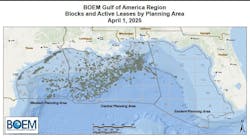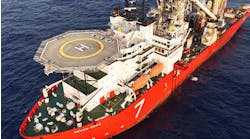Offshore energy: moving the world forward
Miles off the US coast, an energy transition is occurring. In the Gulf of Mexico and along the Atlantic seaboard, oil and gas platforms and the offshore wind farms being planned offer an opportunity to transition American energy production to a lower carbon future. The offshore industry – oil, natural gas, and wind – is driving the innovation the world needs to truly transform energy production.
Through technological innovation and ingenuity, the women and men of the offshore industry are showing the world they can have their energy cake and eat it too.
The high-tech innovation developed by the offshore seem beyond the wildest imagination of a Hollywood sci-fi script. From satellites to subsea autonomous robots to machine learning and artificial intelligence our industry is constantly driving technological progress.
In the Gulf of Mexico, the advancement of technology has turned the region into an American energy and lower emissions asset. Gulf of Mexico oil production has a carbon-intensity one-half of other oil producing regions. Deepwater production, which accounts for 92% of production in the Gulf of Mexico, provides the lowest carbon intensity of any oil producing region.
The deepwater Gulf of Mexico, which has been called the future of the Gulf of Mexico, is today responsible for 92% of total Gulf of Mexico oil and gas production. Deepwater platforms sit like oak trees, one solid trunk linked to a network of powerful roots. Just 18 deepwater facilities are responsible for 75% of offshore production and 10% of total U.S. oil and gas production.
Thanks to innovation, Gulf of Mexico oil and natural gas production has been an economic and environmental anchor for America for decades. The National Ocean Industries Association (NOIA) commissioned a study in 2020 to look at the widespread Gulf of Mexico economic impact. The results were astounding.
More than 345,000 women and men are part of the Gulf of Mexico oil and gas industry. Our industry also has a $28.6 billion impact on US GDP. What is especially astounding is that our jobs and investments are not isolated along the Gulf Coast. Yes, Texas, Louisiana, Mississippi and Alabama receive the lion’s share of jobs and investments tied to the Gulf of Mexico, but those benefits are widely distributed throughout the country. From buoy experts in Maine to software companies in Florida to concrete specialists in Hawaii, every US state has businesses and employees linked to the offshore industry.
The Gulf of Mexico also benefits America through the funding of vital conservation and outdoor recreation programs. In particular, the Land & Water Conservation Fund receives virtually its entire funding from Gulf of Mexico oil and gas production. More than $1 billion was generated for this critical program in 2019. Since its inception, more than $3.9 billion in funding has gone towards projects that have been found in every county in every US state and territory.
The Land & Water Conservation Fund also provides funding for programs like the Outdoor Recreation Legacy Program. More than $30 million has been delegated to more than 50 disadvantaged communities over the past six years to build new parks or improve existing ones in poorer urban neighborhoods, providing safe community oases that normally would not exist.
Offshore wind is also ready to soar as projects are closer to becoming reality along the Atlantic Coast. After permitting delays and a growing backlog of projects, the federal review of Vineyard Wind, a joint venture between Avangrid Renewables and Copenhagen Infrastructure Partners, has resumed. Federal regulators are also progressing their review of South Fork Wind, a wind project offshore Long Island by Ørsted and Eversource. And we expect several more will soon wind their way through the process.
With a clear and stable regulatory and permitting regime, the wind industry will be able to develop and deploy new technologies and provide a reliable supply of clean energy. The Vineyard Wind project is already planning to utilize the massive GE Renewable Energy Haliade-X wind turbine generators. Called “monster” turbines, the machines will have a generating capacity that would have been almost unimaginable a decade ago. A single turbine will be able to turn out 13 megawatts of power, enough to light up a town of roughly 12,000 homes.
Innovation and the dedication of the women and men of the offshore has enabled the industry to solve incredible challenges and achieve amazing feats. Our organization launched the NOIA Environmental, Social & Governance (ESG) Network in 2020 to align the industry to solve some of the most pressing challenges facing the US and the world.
From top to bottom, NOIA members are already embracing ESG principles as dedicated stewards of the environment and of local communities. The principles also include a climate change provision, where companies agree to “be part of a systematic approach to addressing the climate challenge.”
In a little more than a year, 40 diverse companies have signed the NOIA ESG Participation Pledge. These companies include oil majors, independent producers, wind developers, subsea system specialists, think tanks, medical experts, heavy lift vessel operators and more.
NOIA members play an irreplaceable role in promoting the solutions that provide the energy vital for lifting society in an environmentally sustainable way. NOIA is proud of the work our members are doing and the seriousness they view improving ESG performance.
Energy demand is rising, and the world is still trying to play catchup with energy distribution. Around 1 billion people still lack access to electricity, and global energy needs are expected to increase by 25% by 2040.
Without the US offshore, energy consumers will be forced to turn elsewhere for their energy needs. Every barrel of oil and every watt of electricity that the women and men of the offshore produce, is energy that our nation does have to import from foreign countries that do not have the same environmental standards as the United States.
The offshore industry is a source of innovation and new technologies that will help drive decarbonization efforts while providing the abundant, affordable and reliable energy we rely upon for a high quality of life. Time and time again, the offshore marketplace has elevated our understanding of what is possible, and the carbon and climate challenges of today will be no different.
The author
Erik Milito is the president of the National Ocean Industries Association, a position he has held since taking helm in November 2019. Prior to NOIA, he served for 17 years with the American Petroleum Institute.




